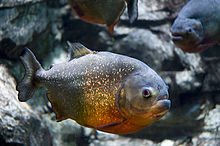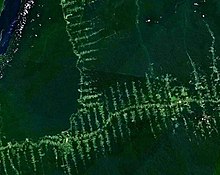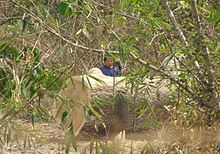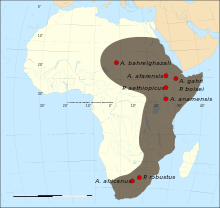Amazon River Basin (the southern Guianas, not marked on this map, are part of the basin)
The mouth of the Amazon River
The Amazon Basin is the part of South America drained by the Amazon River and its tributaries. The Amazon drainage basin covers an area of about 6,300,000 km2 (2,400,000 sq mi), or about 35.5 percent that of the South American continent. It is located in the countries of Bolivia, Brazil, Colombia, Ecuador, Guyana, Peru, Suriname and Venezuela.
Most of the basin is covered by the Amazon Rainforest, also known as Amazonia. With a 5,500,000 km2 (2,100,000 sq mi) area of dense tropical forest, this is the largest rainforest in the world.
Geography
The Amazon River begins in the Andes Mountains at the west of the basin with its main tributary the Marañón River in Peru. The highest point in the watershed of the Amazon is the peak of Yerupajá at 6,635 metres (21,768 ft).
With a length of about 6,400 km (4,000 mi) before it drains into the Atlantic Ocean, it is one of the two longest rivers in the world; a team of Brazilian scientists has claimed that the Amazon is longer than the Nile
but debate about its exact length continues.
The Amazon system transports the largest volume of water of any
river system, accounting for about 20% of the total water carried to the
oceans by rivers.
Some of the Amazon rainforests are deforested because of the increasing of cattle ranches and soy beans field.
The Amazon basin formerly flowed west to Pacific Ocean until the Andes formed, causing the basin to flow eastward towards the Atlantic Ocean.
Politically the basin is divided into the Brazilian Amazônia Legal, the Peruvian Amazon, the Amazon region of Colombia and parts of Bolivia, Ecuador and the Venezuelan state of Amazonas.
Plant life
Aerial view of part of the Amazon rainforest.
Plant growth is dense and its variety of animal inhabitants is
comparatively high due to the heavy rainfall and the dense and extensive
evergreen and coniferous forests. Little sunlight
reaches the ground due to the dense roof canopy by plants. The ground
remains dark and damp and only shade tolerant vegetation will grow here.
Orchids and bromeliads exploit trees and other plants to get closer to the sunlight. They grow hanging onto the branches or tree trunks with aerial roots, not as parasites but as epiphytes. Species of tropical trees native to the Amazon include Brazil nut, rubber tree and Assai palm.
Animal life
Mammals
More than 1,400 species of mammals are found in the Amazon, the majority of which are species of bats and rodents. Its larger mammals include the jaguar, ocelot, capybara and South American tapir.
Birds
About 1500 bird species inhabit the Amazon Basin. The biodiversity
of the Amazon and the sheer number of diverse bird species is given by
the number of different bird families that reside in these humid
forests. An example of such would be the cotinga family, to which the Guianan cock-of-the-rock belong. Birds such as toucans, and hummingbirds are also found here. Macaws are famous for gathering by the hundreds along the clay cliffs of the Amazon River. In the western Amazon hundreds of macaws and other parrots descend to exposed river banks to consume clay on an almost daily basis, the exception being rainy days.
Reptiles
The green anaconda inhabits the shallow waters of the Amazon and the emerald tree boa and boa constrictor live in the Amazonian tree tops.
Many reptiles
species are illegally collected and exported for the international pet
trade. Live animals are the fourth largest commodity in the smuggling
industry after drugs, diamonds, and weapons.
Amphibians
More than 1,500 species of amphibians swim and are found in the Amazon. Unlike temperate frogs which are mostly limited to habitats
near the water, tropical frogs are most abundant in the trees and
relatively few are found near bodies of water on the forest floor. The
reason for this occurrence is quite simple: frogs must always keep their
skin moist since almost half of their respiration is carried out through their skin. The high humidity of the rainforest and frequent rainstorms gives tropical frogs infinitely more freedom to move into the trees and escape the many predators of rainforest waters. The differences between temperate and tropical frogs extend beyond their habitat.
Red-bellied piranha (Pygocentrus nattereri) is a species of piranha. This species lives in the Amazon River basin, coastal rivers of northeastern Brazil, and the basins of the Paraguay, Paraná and Essequibo Rivers.
Fish
About 2,500 fish species are known from the Amazon basin and it is estimated that more than 1,000 additional undescribed species exist. This is more than any other river basin on Earth, and Amazonia is the center of diversity for Neotropical fishes. About 45% (more than 1,000 species) of the known Amazonian fish species are endemic to the basin.
The remarkable species richness can in part be explained by the large
differences between the various parts of the Amazon basin, resulting in
many fish species that are endemic to small regions. For example, fauna
in clearwater rivers differs from fauna in white and blackwater rivers, fauna in slow moving sections show distinct differences compared to that in rapids,
fauna in small streams differ from that in major rivers, and fauna in
shallow sections show distinct differences compared to that in deep
parts. By far the most diverse orders in the Amazon are Characiformes (43% of total fish species in the Amazon) and Siluriformes (39%), but other groups with many species include Cichlidae (6%) and Gymnotiformes (3%).
In addition to major differences in behavior and ecology, Amazonian fish vary extensively in form and size. The largest, the arapaima and piraiba can reach 3 m (9.8 ft) or more in length and up to 200 kg (440 lb) in weight, making them some of the largest strict freshwater fish in the world. The bull shark and common sawfish, which have been recorded far up the Amazon, may reach even greater sizes, but they are euryhaline and often seen in marine waters.
In contrast to the giants, there are Amazonian fish from several
families that are less than 2 cm (0.8 in) long. The smallest are likely
the Leptophilypnion sleeper gobies, which do not surpass 1 cm (0.4 in) and are among the smallest fish in the world.
The Amazon supports very large fisheries, including well-known species of large catfish (such as Brachyplatystoma, which perform long breeding migrations up the Amazon), arapaima and tambaqui, and is also home to many species that are important in the aquarium trade, such as the oscar, discus, angelfish, Corydoras catfish and neon tetra.
Although the true danger they represent often is greatly exaggerated,
the Amazon basin is home to several feared fish species such as piranhas (including the famous red-bellied), electric eel, river stingrays and candiru. Several cavefish species in the genus Phreatobius are found in the Amazon, as is the cave-dwelling Astroblepus pholeter in the far western part of the basin (Andean region). The Tocantins basin, arguably not part of the Amazon basin, has several other cavefish species.
The deeper part of the major Amazonian rivers are always dark and a few
species have adaptions similar to cavefish (reduced pigment and eyes).
Among these are the knifefish Compsaraia and Orthosternarchus, some Cetopsis whale catfish (especially C. oliveirai), some Xyliphius and Micromyzon banjo catfish, and the loricariid catfish Loricaria spinulifera, L. pumila, Peckoltia pankimpuju, Panaque bathyphilus and Panaqolus nix (these five also occur in "normal" forms of shallower waters). The perhaps most unusual habitat used by Amazonian fish is land. The splash tetra is famous for laying its eggs on plants above water, keeping them moist by continuously splashing on them, the South American lungfish can survive underground in a mucous cocoon during the dry season, some small rivulid
killifish can jump over land between water sources (sometimes moving
relatively long distances, even uphill) and may deliberately jump onto
land to escape aquatic predators, and an undescribed species of worm-like Phreatobius catfish lives in waterlogged leaf litter near (not in) streams.
Some of the major fish groups of the Amazon basin include:
- Order Gymnotiformes: Neotropical electric fishes
- Order Characiformes: characins, tetras and relatives
- Family Potamotrygonidae: river stingrays
- Family Arapaimidae: bonytongues
- Family Loricariidae: suckermouth catfishes
- Family Callichthyidae: armored catfishes
- Family Pimelodidae: pimelodid catfishes
- Family Trichomycteridae: pencil catfishes
- Family Auchenipteridae: driftwood catfishes
- Subfamily Cichlinae: pike cichlids, peacock cichlids and relatives
- Subfamily Geophaginae: Eartheaters and Neotropical dwarf cichlid
- Subfamily Poeciliinae: guppies and relatives
Insects
More than 90% of the animal species in the Amazon are insects, of which about 40% are beetles (Coleoptera constituting almost 25% of all known types of animal life-forms).
Whereas all of Europe has some 321 butterfly species, the Manú National Park in Peru (4000 hectare-survey) has 1300 species, while Tambopata National Reserve (5500 hectare-survey) has at least 1231 species.
Climate and seasons
The Amazon River basin has a low-water season, and a wet season during which, the rivers flood the adjacent, low-lying forests. The climate of the basin is generally hot and humid.
In some areas, however, the winter months (June–September) can bring
cold snaps, fueled by Antarctic winds travelling along the adjacent
mountain range. The average annual temperature is around 25 degree and
30 degree Celsius with no distinction between summer and winter seasons.
Human lifestyle
Amazonia is sparsely populated.
There are scattered settlements inland, but most of the population
lives in a few larger cities on the banks of the Amazon and other major
rivers, such as in Iquitos, Peru, and Manaus and Belém (Brazil). In many regions, the forest has been cleared for soya bean plantations and ranching (the most extensive non-forest use of the land); some of the inhabitants harvest wild rubber latex, and Brazil nuts.
This is a form of extractive farms, where the trees are not cut down.
These are relatively sustainable operations in contrast to lumbering or
agriculture dependent on clearing the rainforest. The people live in
thatched houses shaped liked beehives. They also build apartment-like
houses called "Maloca", with a steeply slanting roof.
The largest organization fighting for the indigenous peoples in this area is COICA. It is a supra organization encompassing all indigenous rights organizations working in the Amazon basin area, and covers the people living in several countries.
River commerce
The river is the principal path of transportation for people and produce in the regions, with transport ranging from balsa rafts and dugout canoes to hand built wooden river craft and modern steel hulled craft.
Agriculture
Seasonal
floods excavate and redistribute nutrient-rich silt onto beaches and
islands, enabling dry-season riverside agriculture of rice, beans, and
corn on the river's shoreline without the addition of fertilizer, with
additional slash and burn agriculture on higher floodplains. Fishing provides additional food year round, and free-range chickens need little or no food beyond what they can forage locally. Charcoal made largely from forest and shoreline deadfall is produced for use in urban areas. Exploitation of bush meat, particularly deer and turtles is common.
Deforestation and increased road-building bring human encroachment upon wild areas, increased resource extraction and threats to biodiversity.
Extensive deforestation, particularly in Brazil, is leading to the extinction of known and unknown species, reducing biological diversity
and adversely impacting soil, water, and air quality. A final part of
the deforestation process is the large-scale production of charcoal for
industrial processes such as steel manufacturing. Soils within the
region are generally shallow and cannot be used for more than a few
seasons without the addition of imported fertilizers and chemicals.
Languages
The most widely spoken language in the Amazon is Portuguese, followed closely by Spanish. On the Brazilian
side Portuguese is spoken by at least 98% of the population, whilst in
the Spanish-speaking countries a large number of speakers of indigenous
languages are present, though Spanish is predominant.
There are hundreds of native languages still spoken in the Amazon, most of which are spoken by only a handful of people, and thus are critically endangered. One of the more widely spoken indigenous languages in the Amazon is Nheengatu, which descends from the ancient Tupi language, originally spoken in the coastal and central regions of Brazil. It was brought to its present location along the Rio Negro
by Brazilian colonizers who, until the mid-17th century, primarily used
Tupi rather than the official Portuguese to communicate. Besides modern
Nheengatu, other languages of the Tupi family are spoken there, along
with other language families like Jê, Arawak, Karib, Arawá, Yanomamo, Matsés and others.














